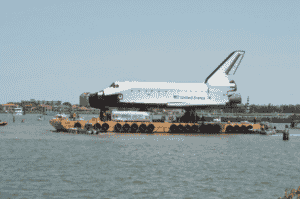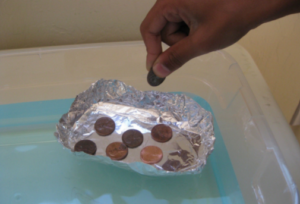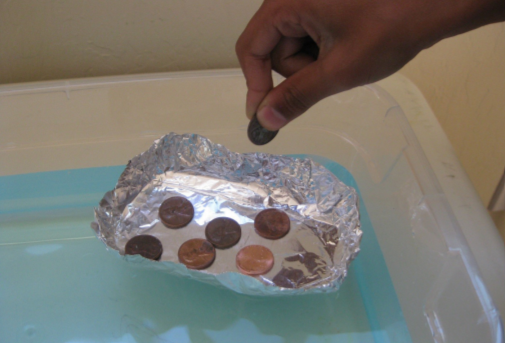Overview
STEM careers
Grade level
Time
Materials
Supplies & Equipment:
|
Consumables:
|
Relevant Terminology

Barges are wide, flat-bottomed boats designed to carry heavy loads, like this replica space shuttle. Credit: NASA.
Buoyancy: An object’s ability to float in water or other fluid.
Density: How much something weighs as compared to how big it is—or, an object’s mass per unit volume. Something big and light, like a balloon, has low density. Something small and heavy, like a rock, has high density.
Displacement: The moving of something from one place to another. For example, when an object is placed in water, it pushes some water out of the way and takes its place.
Introduce
GETTING READY
Cut the foil into uniform squares. The foil squares can be anywhere from 4″ x 4″ to 12″ x 12″. Keep in mind that larger squares will make larger boats, which may require more pennies to sink. Fill your plastic bin with a few inches of water. Have towels ready to dry your hands or clean up spills.
INTRODUCTION
Ask questions to get participants thinking about why objects sink or float:
- Think about different boats you have seen. What is the same about them? How are they different? (Similar shapes or materials, different means of propulsion, etc.)
- What makes a boat float? (Boats weigh less than the water they push aside.)
- What’s a common way to ship things across the ocean? (Cargo ship or freighter.) Some cargo ships travel with a load of containers that is larger than the ship—why do you think it doesn’t sink? (Their flat, hollow design keeps them buoyant.)
Instructions

Participants place pennies in their boat one at a time. Be sure to have them distribute the weight evenly. Credit: Maria Kapadia/Science 4 Superheroes.
Ask participants more focused questions about buoyancy. What happens to a full glass of water when you add a bunch of ice cubes to it? What happens to a ship when more and more weight is added to it?
Introduce the design challenge.
Give each person or team a square of aluminum foil.
Give participants as much time as they need to build their boats. They may test them to make sure they float before adding weight.
Start adding weight to the boat. Make sure to distribute the weight evenly.
- Place pennies one by one into the boat. Participants can keep track or count along.
- Keep adding weight until the boat sinks.
- Make observations along the way. Does the boat change shape, spring a leak, or lean in one direction?
Ask questions to encourage further discovery. Redesign the boat and test again.
ACTIVITY VARIATIONS
Calculate the weight of displaced water just before sinking. Add the weight of the dry foil boat plus the weight of the pennies. A standard US cent weighs 2.5g. Was this more or less than you thought the boat could hold?
Use other materials for building the boat, like clay or paper.
After testing a boat in water, try another fluid. Will the boat hold the same amount of weight floating on salt water? What about vegetable oil?
TROUBLESHOOTING
If a boat doesn’t remain upright, consider a wider design.
If a boat sinks before you think it should, make sure you are distributing weight evenly.
Wide, flat-bottomed boats will hold the most weight. If participants are frustrated, give them hints but try not to blatantly tell them how to build their boat.
Guiding questions
GUIDANCE FOR YOUNGER CHILDREN
QUESTIONS TO ASK AFTER THE ACTIVITY
- What kind of real-world boat did your boat look like?
- How many pennies was your boat able to hold? Did it matter how or where you placed the pennies in your boat?
- After testing your boat, did you make any changes to the shape of your boat? Why or why not?
- What shapes seemed to work the best?
- What could you change to make your boat hold more weight before sinking?
- Did your boat tip over before it sank? And if so, what changes did you make to stop this from happening?
- Why do the pennies float when placed in the boat but sink when placed directly into the water?
GUIDANCE FOR OLDER YOUTH AND ADULTS
QUESTIONS TO ASK AFTER THE ACTIVITY
- What type of boat did you use as a model for your foil boat? Why did you think this would be the best idea for holding lots of pennies?
- What factors did you consider when designing your boat?
- Given more time, what changes could you have made so that your boat would hold more pennies?
- Did your boat capsize? If it did, how could you have prevented this from happening?
- Did the placement of the pennies affect your boat’s ability to float?
- How does the shape of your boat affect the boat’s buoyancy?
Engineering & science connections
GUIDANCE FOR YOUNGER CHILDREN
Engineering Connections
For a boat to float, it needs to weigh less than the same amount, or volume, of water. To make this happen, engineers must build boats so that they have giant pockets of air inside them. If you think about a huge cargo ship or a cruise ship, you will realize that most of the ship’s interior is open space. The weight of the ship is spread out across a large area so that compared to the same volume of water, the water weighs much more than the ship.
Boats have different shapes depending on what they are used for. Boats that are flat on the bottom do not sink very deep into the water because their weight is spread over a large area, making the weight of the boat less than the weight of the water that the boat pushes aside. These boats are used for traveling in shallow water. They can also hold larger amounts of weight. They would be perfect for carrying lots and lots of pennies!
Science Connections
Why does a rock sink in water while a giant cruise ship will float? An ancient Greek scientist named Archimedes was the first person to figure out the science behind what makes some objects float while others sink. He found that when an object is placed in water, it pushes enough water out of the way to make room for itself. You’ve seen this idea in action if you have ever stepped into a full tub and had the water level rise and spill over the top to make room for you.
When an object is placed in water, there are two forces that act on it: a downward force, called the object’s weight, and an upward force, which is equal to the weight of the water that the object pushes out of its way. If the downward force is less than the upward force, the object will float. This is why a rock will sink while giant cruise ships float. The rock weighs more than the amount of water that it pushes out of its way. The cruise ship, however, weighs less than the huge amount of water that it pushes out of its way.
GUIDANCE FOR OLDER YOUTH AND ADULTS
Engineering Connections
When designing a boat, engineers give lots of consideration to the shape of its hull. The hull isn’t very noticeable because most of it is under water. However, the first question that engineers need to ask is, “How will this boat be used?” The answer to that question determines the boat’s design. For example, if the boat is meant to travel in shallow water, at very high speeds, or carry a large amount of material, a flat-bottom hull might be a good design. These boats float high in the water, thereby minimizing the amount of water that the boat must push out of the way as it cruises through it. This, in turn, reduces the friction between the water and the boat, allowing it to travel very quickly. Also, since flat-bottom boats sit fairly high in the water, they are very useful for moving around in shallow waters. However, sitting high positions the boat’s center of gravity above the surface of the water, which is not an advantage in rough seas. In this situation, flat-bottom hulls are less stable than other kinds and more likely to capsize (tip over).
Science Connections
Whether an object floats or sinks depends on its density and its ability to displace water. An object placed in water will displace an amount of water equal to its volume. When an object enters the water, there are two forces acting on it: the force of gravity pulling the object down, and the buoyant force of the water pushing upward. According to Archimedes’s principle, the buoyant force is equal to the weight of the water that an object displaces. Therefore, if the buoyant force acting on an object is greater than the weight of the object, the object will float. To test this, you could fill the hull of a boat with water. You could then weigh all of this water and compare it to the weight of the empty hull. If the water weighs more, then the boat will float. If the water weighs less than the boat, the boat will sink.
This version of the activity provided by Liberty Science Center. All rights reserved.
Supplemental content adapted for Dream Big Activities by the Carnegie Science Center.


0 Comments